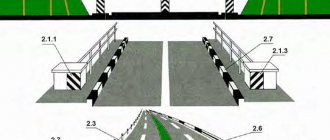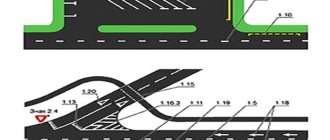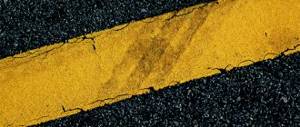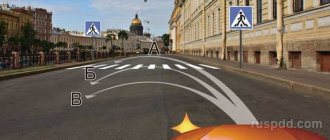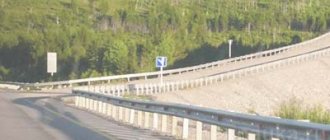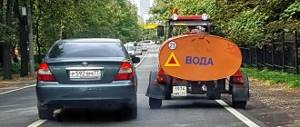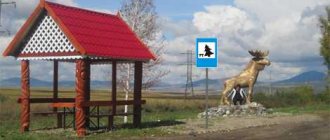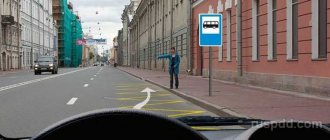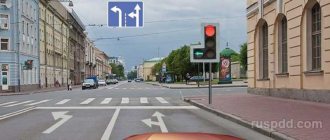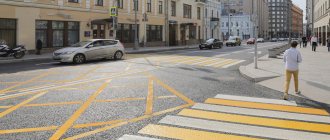Summer is rightfully considered the best time of the year for traffic police inspectors in the sense that it is at this time of year that they issue a lot of fines to motorists. Moreover, this widespread phenomenon is explained not only by habitual traffic violations, but also by the activation of road organizations that either simply “patch” potholes or carry out road reconstruction. When organizing work, permanent white road markings often disappear along with the removed asphalt surface, replacing which temporary ones are applied or appropriate signs are installed.
And it also happens that temporary marking lines are adjacent to permanent markings. Accordingly, many drivers, as a result of such leapfrog, have a misunderstanding of what to do in such conditions. As a result, even experienced car owners often fall into a trap, and law enforcement officials literally collect a month’s “tribute” in the form of “chain letters” in just a day.
Therefore, the question is how to protect yourself from incorrectly solving such road puzzles - and often special, deliberate traffic police traps - and understand the contradictions between temporary markings, permanent ones and road signs, which can also be applied only for a short period? Firstly, if possible, you need to regularly refresh your knowledge of traffic rules by repeating the theory and checking the correctness of the answers in online exams.
Secondly, turn on observation and notice when experienced drivers ignore orange markings and this does not entail administrative punishment. Finally, study the regulatory framework in accordance with which decisions should be made while driving. This article partially addresses this issue, the data for which was taken as of mid-2021. Fortunately, the unfortunate coronavirus did not become a compelling reason for adopting new rules regarding which markings are temporary and which are not...
Temporary markings: color and line types
Current traffic regulations do not regulate what type of lines may indicate temporary orange markings. Therefore, it is logical that they can be anything: designed to duplicate speed limit signs, separate oncoming and passing traffic flows, prescribe driving in certain lanes, etc. Also, temporary markings by default can be used instead of yellow lines, which are permanent - along the roadsides , near public transport stops, at pedestrian crossings, etc., since yellow or orange is more visible than white. Of course, temporary lines are drawn in any case at the places where repair work is carried out.
LIFE HACK. Numerous road companies in Russia, contracted to repair roads, choose shades of yellow markings arbitrarily, as God pleases. And this does not contradict the traffic rules, in which the color scheme for such cases is not prescribed. For this reason, temporary road markings may appear similar to permanent yellow markings, which can cause confusion and confusion for drivers. How can you visually distinguish these two types of lines? It's very simple: as a rule, yellow lines are thicker than orange ones. In addition, orange markings can be exclusively horizontal.
What does the traffic regulations say?
Road markings are lines, inscriptions, arrows and other elements on the road surface and road structures that establish the rules and procedure for the movement of vehicles and pedestrians, as well as informing about certain conditions and requirements. Marking can be permanent or temporary. If there is a temporary marking, you must be guided by its requirements and instructions, since it takes precedence over permanent markings.
IMPORTANT! Temporary markings in Russia are applied in orange or red. It can be applied on top of or next to the permanent one. The peculiarity is that it can be washed off when there is no longer a need for it.
Possible types of temporary markings
Most types of horizontal markings can be applied as a temporary option. The most common:
- 1.1 Solid line;
- 1.3 Double solid;
- 1.14.1 and 1.14.2 Pedestrian crossing (zebra crossing). These markings are quite voluminous and are used, as a rule, in cases where road work continues for several weeks;
- 1.18 In the form of arrows in various combinations (indicates direction);
- 1.24.1-1.24.4 Duplicate road signs (speed limits and others).
The traffic rules do not provide a clear list of marking numbers, which may be temporary. Based on this, we can conclude that temporary markings can be of any kind.
Many drivers confuse yellow and orange markings. The colors perform different functions: orange lines are temporary, and yellow lines are permanent, assigned to certain types of road markings (waffle iron, public transport stops, etc.).
Where, when and what is it used for
Most often, temporary markings are used during road works, when it is necessary to change the trajectory of traffic or dangerous conditions are created for maneuvers (for example, one lane is closed, etc.).
Temporary markings are used:
- To ensure the removal and stabilize the deviation of traffic along the width of the lane in the direction of changing the trajectory of transport.
- To notify about changes in road configuration (narrowing, detour points, etc.).
- To determine the buffer area and designate the work site in places bordering the lanes along which traffic moves.
The road inspection must install an information sign in advance stating that temporary road markings will soon be applied to this section of the road (and indicate the reason).
Differences between temporary road signs and permanent ones
In short, temporary road signs have a yellow background rather than a white one. Their list can be easily found in the traffic rules, but basically they are:
warn about road works;
prohibit, limit speed along certain sections;
report changes in the configuration of the highway (detour, narrowing of the road, etc.).
However, it is not enough to know the purpose of certain temporary signs; it is equally important to understand how they are combined with temporary and permanent horizontal markings, as well as the main signs on the road.
How to avoid falling into traffic police traps?
Well, summer is in full swing, which means now is the best time for traffic police. Summer is the busiest time for road workers involved in road reconstruction/repair. After all, when repairing roads, as a rule, temporary road signs and temporary markings are used, or, even worse, the markings disappear along with the removed asphalt. At this time, many drivers are dizzy from the variety of permanent and temporary road signs and markings changing from white/yellow to orange. As a result, even experienced motorists often fall into the traps of traffic police officers, who are very fond of keeping watch over unlucky drivers in such places, collecting the entire monthly fine plan in one day. So how can you protect yourself from these types of DPS traps? How to understand the contradictions that often occur on the road between permanent road signs and temporary ones, as well as how to understand which markings are more important and what to do when the markings contradict the signs?
Have you noticed how traffic police crews like to “herd” the flow of cars on sections of the road with temporary markings (orange road markings)? Do you know why? The thing is that in the area covered by temporary road markings, people often forget (or don’t put them on purpose) to install temporary road signs that do not contradict the temporary markings. As a result, an interesting puzzle forms on the road, which sometimes even experienced drivers do not have time to solve. The reason is that most motorists on the road simply forget the current Traffic Rules (and to prevent this from happening, we still recommend that you repeat the theory from time to time, testing yourself in various online traffic rules exams), resulting in confusion about what is more important : permanent sign, temporary sign, permanent marking or temporary. You've probably seen many drivers ignoring temporary orange markings on the road. But not all. Some people ignore permanent road signs and follow the orange lines on the road. What do you think, if permanent or temporary signs conflict with road markings, what should a driver do to avoid violating traffic rules?
Traffic police officers especially like to “guard” sections of the road where temporary markings pass through “oncoming traffic.” Moreover, surprisingly, you often come across orange markings on the road, passing through oncoming traffic lanes in places where there is no sign of any road work. And such a “temporary paint” can remain on the road for months, despite the fact that there are no signs of road work even close.
As a result, all shifts of local traffic police crews like to stand in such places. Especially if such markings contradict established road signs. As a result, in this place you can plan out more than one protocol in just a few hours, exceeding the annual plan, which, as the traffic police authorities say, they allegedly do not have (but you and I know that there is still a plan for administrative protocols).
See also: Stopping and parking is prohibited: what the fine means and in what cases the sign is not valid
What is usually the catch when permanent, temporary road signs conflict with permanent or temporary markings? The fact is that the calculation in such arranging signs and applying temporary markings is simple here. Many drivers simply forget the primacy of permanent and temporary road signs over road markings.
Therefore, we advise everyone, especially before the start of the road reconstruction season, to repeat the traffic rules so as not to forget how to resolve frequent contradictions between regular and temporary road signs, as well as how to interpret the situation when road markings (permanent or temporary) contradict road signs.
So, let us remind you that according to the current Traffic Rules, in cases where on the road the meanings of temporary road signs and stationary (permanent) road signs contradict each other, drivers MUST be guided by the temporary signs (Appendix “Road Signs” No. 1 of the Traffic Regulations of the Russian Federation, chapter 
/ed. Decree of the Government of the Russian Federation dated July 23, 2013 No. 621/
So, now let's remember what the Traffic Rules say about the situation when road markings contradict established road signs. How do you think you should be guided by such a contradiction?
To do this, let’s turn to Appendix 2 “Road markings” of the Russian Traffic Regulations.
This is what Chapter 1 “Horizontal markings” of Appendix 2 to the Russian Traffic Regulations says:
“In cases where the meanings of road signs, including temporary ones, and horizontal marking lines contradict each other or the markings are not sufficiently distinguishable, drivers must be guided by the road signs. In cases where temporary marking lines and permanent marking lines contradict each other, drivers must be guided by the temporary marking lines.”
Accordingly, according to the current Traffic Rules, if there are road signs on the road (no matter what - stationary or temporary), no markings can cancel them. Accordingly, if road markings (no matter whether permanent or temporary) contradict road signs, you must follow the road signs. Otherwise, you will violate traffic rules and may be subject to administrative liability. Also, if temporary marking lines contradict permanent road markings, drivers are required, according to traffic regulations, to follow the temporary markings.
What is stated in the Rules?
According to the traffic rules, if the meanings of signs (including those of a temporary nature) and horizontal road marking lines are not valid, that is, they conflict, then traffic participants are required to follow the instructions of the road signs. The same rule applies in cases where horizontal markings are difficult to distinguish. In addition, if for some reason the temporary markings on the road are not consistent with the permanent ones, then car owners must give priority to the instructions of the temporary lines.
Of course, this formulation requires detailed explanation. As for the markup, everything is quite transparent: temporary is always more important than permanent. But what if there are both permanent and temporary signs installed on the road, which one has priority? Regarding this, the Rules also have a clear instruction - a temporary sign always prevails over the instructions of a permanent sign.
And we should consider the third, most difficult case, when there are permanent, temporary road signs and orange lines on the road. It is clear that permanent markings should be ignored, because temporary markings are more important. However, the temporary sign is “stronger” than the permanent one. That is, the essence of the question is who has priority - the temporary sign or the lines, also applied only for a certain period? The answer may not be on the surface, but it is still there: temporary road signs are more important than temporary markings.
LET'S SUM UP.
So, in order not to get confused, you need to build a logical chain of three points, which helps you quickly and accurately navigate a specific road section.
Temporary orange road markings are always more important than permanent ones - white or yellow.
A temporary road sign with a yellow background takes precedence over a permanent sign with a background of any color.
A temporary sign is a dominant sign that cancels the instructions of both signs and lines of both a permanent and temporary nature.
There is another important question - is it possible to get a fine for violating traffic rules in relation to temporary signs and lines? Here you need to take into account not only the Traffic Rules, but also the Code of Administrative Offenses of the Russian Federation (CAO).
Which markup has an advantage?
Many motorists do not know what color temporary markings are, so when they see non-white markings on the road, they often get lost. You need to remember that most often the color of road markings is orange, although options are possible when red or yellow markings are applied. Such bright colors were not chosen by chance.
They attract the attention of drivers more significantly than the usual white color. Thus, the road user subconsciously understands that a brighter color of road markings has a greater advantage over the standard one, and therefore will follow it.
Administrative responsibility, for which they are punished
Since the Code of Administrative Offenses does not contain clauses that would distinguish temporary signs and markings from the main ones, fines are imposed on drivers for violating traffic rules within their coverage area. For example, if a permanent sign limits the speed limit to 50 km/h, and a temporary sign reduces driving dynamics to 40 km/h and no more, then driving at a speed of 41 km/h entails administrative liability. It’s not for nothing that from 2021 we are allowed to install speed control cameras in the zone of influence of temporary road signs...
Let us repeat: violation of temporary graphic signs and road markings is legally equivalent to violation of permanent road signs. Accordingly, in the “sphere of influence” of a sign with a yellow background “Overtaking prohibited,” overtaking through a solid line is punishable by a fine of five thousand rubles or deprivation of driving privileges for a period of 4 to 6 months, and ignoring the instructions of a temporary traffic light leads to a less strict, but still same punishment in the form of having to pay 1,000 rubles to the treasury.
In order not to list the entire list of offenses and publish a table with the size of the fine, we simply note: the punishment will be the same as in the case of violation of the requirements of basic graphic signs and main lines. In the end, the amounts that drivers at fault must pay are constantly changing. Unfortunately, only in the direction of increase...
Possible violations and liability for them
Responsibility for violation of the requirements imposed by markings is established in the Code of Administrative Offenses, and the code does not divide the amount of punishment for violations of recommendations given by permanent or temporary markings.
Crosswalk
Sometimes, due to major road reconstruction, a temporary relocation of the pedestrian crossing occurs.
A rule will apply to it: stopping or parking on it, or performing the same actions in front of it at a distance closer than 5 meters is prohibited. This type of offense is punishable by Part 3 of Art. 12.19 of the Administrative Code in the amount of 1000 rubles. If the driver leaves the car, the traffic police officer may decide to evacuate the vehicle.
Therefore, in addition to a fine for violating traffic rules, an inattentive driver will also have to pay for the services of a tow truck and the cost of a parking lot. Federal Law No. 143 of 06/08/2015 added an additional clause to Art. 27.13 of the Administrative Code, which regulates the evacuation procedure.
According to the innovation, if the driver of the car appears at the time of drawing up the protocol or loading it onto a tow truck, but before it starts moving, the vehicle must be handed over. But sanctions for violating traffic rules will still be applied.
Driving through the intersection
When crossing a controlled intersection, that is, one where traffic is regulated by traffic lights or gestures of a traffic controller, you need to pay attention to the presence of markings 1.12. It alerts drivers to stop immediately in front of it and is called a “stop line.”
In accordance with clause 6.13, if there is such a line at an intersection, the driver must stop in front of it when required by a traffic light or traffic controller.
For violation of this rule, liability is established under Art.
12.12 Code of Administrative Offences, in the amount of 800 rubles. This marking is also used in conjunction with sign 2.5 “Driving without stopping is prohibited.” It's a red octagon with the word "STOP" written on it. In addition to intersections, both controlled and not, it can be installed in front of a railway crossing.
Liability for violating the markings that exist together with the “STOP” sign will depend on the place where it was committed. If the violation occurred at an intersection, then this act is qualified under Part 1 of Art. 12.16. Then you will have to pay 500 rubles to the treasury. True, the norm provides for another version of liability - a warning.
The need to stop when approaching the railway tracks is established by clause 15.4 of the traffic rules. If the violation occurred before the railway crossing, then it is already qualified under Part 2. Art. 12.10 of the Administrative Code, which determines the penalty in the form of an administrative fine of 1000 rubles without offering an alternative option.
Solid
Crossing solid 1.2 marking the edge of the roadway, followed by driving along the side of the road, is punishable in accordance with Part 1 of Art. 12.15 Code of Administrative Offenses, a fine of 1,500 rubles.
If marking 1.23.2, indicating a path for pedestrians, or 1.23.3, defining a place for cyclists where motorists are prohibited from moving, is not followed, then those who violate this rule will have to pay 2,000 rubles.
Crossing a continuous road, if the driver drives into oncoming traffic, will be punished differently, depending on the reasons for this maneuver.
If this was done to avoid an obstacle, then the amount of liability is limited only by a fine and varies from 1000 to 1500 rubles. An obstacle, in accordance with clause 1.2 of the Traffic Regulations, is considered to be any object or defect in the road surface that appears on the path of movement.
Please note that a traffic jam is not considered an obstacle. Therefore, if you decide to go around it in the oncoming lane, and even crossed a solid line, then be prepared for the fact that more serious liability is provided for this violation.
You may either be fined 5,000 rubles or be deprived of the right to drive a vehicle for a period of 4 to 6 months.
If this offense was committed again, you will have to part with your rights for a year. But if you are held accountable based on data from cameras recording offenses on the road, then you can only be ordered to pay a fine of 5,000 rubles.
If a continuous line is crossed as a result of a left turn or a U-turn, then liability arises under Part 2 of Art. 12.16 Code of Administrative Offences. Special attention must be paid to this circumstance, since inspectors often try to apply the more severe punishment described above when committing this violation. But in this case, we can only talk about collecting an administrative fine from 1000 to 1500 rubles.
Bus Lane
The letter A may be drawn on the road, which corresponds to the marking number 1.23.1.
Together with signs 5.11.1, 5.13.1, 5.13.2, 5.14, it indicates the allocation of a specialized lane for public transport and passenger taxis. However, in this case it is also necessary to pay attention to the signs installed nearby. The fact is that the allocation of a band may not always occur, but only at a certain time.
If this is the case, then additional information signs will be installed nearby to notify about the duration of the ban. For example, the restriction may apply only to working days or only to specific hours on certain days.
Failure to comply with the requirements for granting the right to move freely along a specialized lane for public transport is punishable in accordance with Art. 12.17 of the Code of Administrative Offences, a fine of 1,500 rubles, and if the same actions were committed in Moscow or St. Petersburg, then it is doubled.
Is it possible to appeal a fine for violating temporary markings and signs?
It is quite obvious that applying orange road markings, as well as installing signs of the same type, often contradict logic. And sometimes one gets the impression that this is done with a very practical intention, the purpose of which is for traffic police inspectors to issue fines. A typical example: on the section of the highway being repaired there are no workers from road construction organizations or special equipment. At the same time, the roadway itself visually looks repaired, but a temporary sign orders driving outside the city at a speed of no more than 50 km/h. Naturally, sooner or later some driver “overshoots” this zone at a “cruising” speed of 80 km/h or more, and it’s not for nothing that the guardians of the law on duty issue a fine. How can I protest their actions?
In this case, the most important thing is to provide evidence of the incompetence of installing a sign limiting driving dynamics, the actions of which contradict the previously accepted traffic organization and clearly do not correspond to the specific situation. And here a video recorder will help, the recording of which shows that the road work is completely completed, there are no fencing structures, but the temporary sign or lines are still there. However, you need to remember that the Administrative Code allows only 10 days from the date of receipt of the “letter of happiness” to appeal a fine.
Secondly, it is not always possible to confirm the absence of an offense by providing evidence. After all, during the time that will pass from the moment of the pseudo-violation to the receipt of a fine, the organization of traffic on the road section where repair work was carried out may well change. Accordingly, the temporary line signs that caused the administrative penalty may be eliminated, and new ones will appear in their place.
Traffic rules of the Russian Federation 2021
Horizontal markings (lines, arrows, inscriptions and other markings on the roadway) establish certain modes and traffic order or contain other information for road users.
Horizontal markings can be permanent or temporary. Permanent markings are white, except for lines 1.4, 1.10 and 1.17, yellow; temporary markings are orange.
Horizontal markings:
1.1
— separates traffic flows in opposite directions and marks the boundaries of traffic lanes in dangerous places on the roads; indicates the boundaries of the roadway to which entry is prohibited; marks the boundaries of vehicle parking spaces;
1.2
- marks the edge of the roadway;
1.3
- separates traffic flows in opposite directions on roads with four or more lanes for traffic in both directions, with two or three lanes - with a lane width of more than 3.75 m;
1.4
(color - yellow) - indicates places where stopping vehicles is prohibited;
1.5
— separates traffic flows in opposite directions on roads with two or three lanes; indicates the boundaries of traffic lanes when there are two or more lanes intended for traffic in the same direction;
1.6
— warns of approaching markings 1.1 or 1.11, which separate traffic flows in opposite or similar directions;
1.7
— indicates traffic lanes within the intersection;
1.8
— marks the boundary between the acceleration or deceleration lane and the main lane of the roadway;
1.9
— indicates the boundaries of the traffic lanes on which reverse regulation is carried out; separates traffic flows of opposite directions (with reverse traffic lights turned off) on roads where reverse control is carried out;
1.10
(color - yellow) - indicates places where parking of vehicles is prohibited;
1.11
— separates traffic flows of opposite or similar directions on sections of roads where changing lanes is allowed only from one lane; indicates places where it is necessary to allow movement only from the side of the broken line (at places of turn, entry and exit from the adjacent territory);
Note: line 1.11 is also allowed to be crossed from the solid side, but only after completing overtaking or detour.
1.12
— indicates the place where the driver must stop when there is a 2.5 sign or when there is a prohibiting traffic light signal (traffic controller);
1.13
— indicates the place where the driver must, if necessary, stop, giving way to vehicles moving along the road being crossed;
1.14.1, 1.14.2
— denotes a pedestrian crossing; marking arrows 1.14.2 indicate the direction of movement of pedestrians;
1.15
- indicates the place where the bicycle path crosses the roadway;
1.16.1, 1.16.2, 1.16.3
— denotes guide islands in places where traffic flows separate or merge;
1.17
— indicates the stopping places of route vehicles and taxi ranks;
1.18
— indicates the lane directions allowed at the intersection. Markings depicting a dead end are applied to indicate that turning onto the nearest roadway is prohibited; markings permitting a left turn from the leftmost lane also permit a U-turn;
1.19
- warns of approaching a narrowing of the roadway (a section where the number of lanes in a given direction is reduced) or marking lines 1.1 or 1.11 separating traffic flows in opposite directions;
1.20
— warns of approaching marking 1.13;
1.21
(sign “STOP”) - warns of approaching marking 1.12 when it is used in combination with sign 2.5;
1.22
— indicates the road number;
1.23.1
— designates a special lane for route vehicles;
1.23.2
— designation of a pedestrian path or pedestrian part of a path intended for the joint movement of pedestrians and bicycles;
1.23.3
— designation of a bicycle path (part of a path) or lane;
1.24.1-1.24.5
— duplication of relevant road signs. Markup 1.24.5 can be used independently;
1.25
— designation of artificial unevenness according to GOST R 52605-2006.
Lines 1.1, 1.2, 1.3 are prohibited from crossing.
Line 1.2. It is allowed to cross to stop a vehicle on the side of the road and when leaving it in places where stopping or parking is permitted.
Lines 1.5 - 1.8 can be crossed from any side.
Line 1.9 in the absence of reversible traffic lights or when they are turned off is allowed to be crossed if it is located to the right of the driver; when reverse traffic lights are on - on any side, if it separates lanes on which traffic is allowed in one direction. When the reversing traffic lights are turned off, the driver must immediately change lanes to the right beyond marking line 1.9.
Line 1.9, separating traffic flows in opposite directions, is prohibited from crossing when the reversible traffic lights are turned off.
Line 1.11 is allowed to be crossed from the broken side, as well as from the solid side, but only upon completion of overtaking or detour.
In cases where the meanings of road signs, including temporary ones, and horizontal marking lines contradict each other or the markings are not sufficiently distinguishable, drivers must be guided by the road signs. In cases where temporary marking lines and permanent marking lines contradict each other, drivers must be guided by the temporary marking lines.
Temporary road signs in traffic regulations and their features
The traffic rules stipulate that the following symbols can be valid for a limited period:
- 1.8, notifying that traffic is regulated by a traffic light;
- 1.15, installed on slippery surfaces;
- 1.16, informing about uneven roads;
- 1.18, warning about the release of gravel under the wheels of the car;
- 1.20.1-1.20.3, installed before the narrowing of the web;
- 1.21, notifying about the establishment of two-way traffic;
- 1.25, informing about road works;
- 1.32, indicating that there is a traffic jam on the way;
- 1.33, warning of danger;
- 1.34.1, 1.34.2, indicating the direction of rotation;
- 2.5, prohibiting driving without stopping;
- 2.6, determining the advantage of oncoming traffic;
- 2.7, limiting the scope of the previous pointer;
- 3.20, prohibiting overtaking in the area;
- 3.21, terminating 3.20;
- 3.24, limiting the maximum permitted speed;
- 3.25, completing the zone of influence of the previous symbol;
- 4.2.1-4.2.3, indicating the need to go around an obstacle;
- 6.17, showing the detour scheme;
- 6.18.1-6.18.3, showing the direction in which to avoid the obstacle;
- 6.19.1, 6.19.2, establishing the need to change lanes to another carriageway when the first one is closed to traffic.
But taking into account specific conditions, any designation can be established for a limited period.
According to traffic regulations, temporary road signs are often combined with each other and supplemented with signs that clarify the territory of their influence or indicate the distance to the problem area. Some of them are rare. Others can be seen in populated areas as well as on highways.
Features of temporary signs and markings
To understand the issue, you need to remember how these signs differ. They are installed in road repair areas and have a yellow background rather than white. Most often, warning signs, prohibitory signs, warning signs indicating road changes, limiting speed, and prohibiting any actions are temporary. Temporary markings also differ from permanent markings in color: they are orange. It should not be confused with yellow markings, which prohibit stopping vehicles.
Time marking priority
Temporary markings are applied with orange paint, permanent markings are painted with white paint. It is worth mentioning separately about signs that may have their own requirements. Sometimes it happens that signs (including temporary ones) and horizontal markings come into conflict. Then the signs are more important. And if the temporary markings contradict the permanent ones, then the driver must comply with the requirements of the temporary ones.
Attention: but stationary road signs are more important than temporary boundaries of road sections!
Priority of temporary signs
The priority of temporary road signs is unconditionally established by the Traffic Regulations. If there are stationary ones nearby, you shouldn’t pay attention to them. Road users must do what the symbol, which is valid for a limited period of time, prescribes.
Features of movement
It turns out that the signs are always more important. But they in themselves do not mean that you can ignore how the road is laid out. Specific examples of confrontation between markings and signs can be seen in popular situations. For example, a solid line and a symbol for the end of the prohibition of overtaking.
You can overtake, unless the driver has to cross a solid line. For the latter, the car owner will face a well-deserved deprivation of rights.
Issues relating to motorists' rights are often more important than they appear at first glance. A driver may lose his license or suffer other severe penalties due to ignorance or misinterpretation of laws and regulations. Do not be lazy to dive deeply into the essence of the issue being studied, do not hesitate to ask advice from professionals.
Yellow road markings
The third type is yellow. Yellow on asphalt is the color of prohibition or the color of warning, sometimes very urgent.
Yellow color indicates:
public transport stops; lines along the sidewalks indicating the coverage areas of the “No Stopping” sign; “waffle irons” at intersections where you cannot stop for more than five seconds, otherwise you will be fined.
Moreover, yellow markings can be used to separate oncoming traffic lanes (not to be confused with orange!). This is done so that drivers can better see a continuous or intermittent or “zebra” pedestrian crossing in bad weather, rain, or snowfall.
Yellow and white markings are equivalent. But, despite the fact that they are such, you need to look for them in different places on the road.
What do markings according to the rules mean?
Lines on the surface of the roadway not only provide information to motorists and pedestrians, but require or prohibit certain actions to be taken. In traffic regulations, the markings of the roadway may not allow, for example, stopping or overtaking, allowing a turn, or obliging you to yield. You need to pay attention not only to the image, but also to the color.
Red
In the section of the rules governing the standards of graphic road schemes, there is information only about black, white, yellow and orange colors. There are no red markings on the road in the traffic regulations. However, in reality the color occurs. And they draw red lines prohibiting travel outside the area limited by them, that is, solid ones, or indicating a dividing strip.
The color is legalized in Austria, Switzerland and, more recently, in Ukraine. There, temporary markings are applied in red when carrying out repair work or for the period of traffic reorganization. In Russia it is used under similar conditions. That is, red should be perceived as orange. This is a timeline whose requirements take priority.
More attention should be paid to the drawing itself. If it is solid red, you are not allowed to cross it. Traffic participants also have nothing to do with the median marking, because it divides the road into sections intended for different directions. Road services can use red paint in the absence of orange.
We recommend reading about traffic rules priority signs. From the article you will learn about what priority signs there are and how to drive under traffic signs. And here is more information about violations of overtaking rules.
Orange
Orange traffic markings on the road are temporary. It is valid for a certain period when the travel features of a section of the track need to be changed. The reason for the orange markings is due to repairs to the road surface and construction going on nearby. The lines may indicate the need to bypass the area, prohibit maneuvers, limit speed, etc. That is, not only the color matters, but also the features of the design he made.
Yellow
Inexperienced drivers may perceive yellow lines as temporary, similar to road signs. But this is a mistaken opinion. Yellow markings on the road traffic rules are defined as permanent, but are used only for some of its types:
- 1.4, which does not allow the vehicle to stop in this place;
- 1.10, prohibiting parking;
- 1.17, applied to mark places of public transport stops and taxi ranks;
- 1.26, adopted in 2021 to delineate the space at the intersection that cannot be occupied if there is a traffic jam ahead if the vehicle does not turn (“waffle iron”).
Yellow stripes are used to improve the visibility of a pedestrian crossing (1.14.1). They are combined with white ones.
solid line
Continuous line markings are one of the most disliked by drivers. Although solid also comes in different types:
- 1.1 limits lanes intended for traffic in opposite directions. Naturally, you can’t cross it; this will be driving into the oncoming traffic.
- 1.2 is applied to mark the boundary of the roadway. Driving outside of it is prohibited. It is also forbidden to drag the wheels while driving. But according to traffic regulations, a solid marking line at the edge of the road can be crossed to stop a vehicle. The same is permitted when leaving the roadside to continue driving.
- 1.3 are never crossed. A double solid line demarcates the flow of oncoming traffic on a multi-lane road.
- 1.4 means it is prohibited to stop at this place. It is painted in yellow.
- 1.11 consists of a dotted line and a solid line, running close and parallel. Applied to separate traffic lanes. You can cross it from the side of the broken line. And from a solid one - only when overtaking or bypassing an obstacle is completed.
- 1.12. It is allowed to cross it. But only after stopping in front of this lane.
Temporary
Temporary traffic markings on the road are defined as superior to permanent ones:
In cases where temporary marking lines and permanent marking lines contradict each other, drivers must be guided by the temporary marking lines.
To attract attention, it is painted in orange. And the image will tell you exactly what actions are prescribed or prohibited for drivers or pedestrians in this area. Only a horizontal designation can be temporary.
